Succeeded by Yorktown class In commission 1934–1946 Length 234 m Launched 25 February 1933 | Built 1931–1934 Completed 1 Construction started 26 September 1931 | |
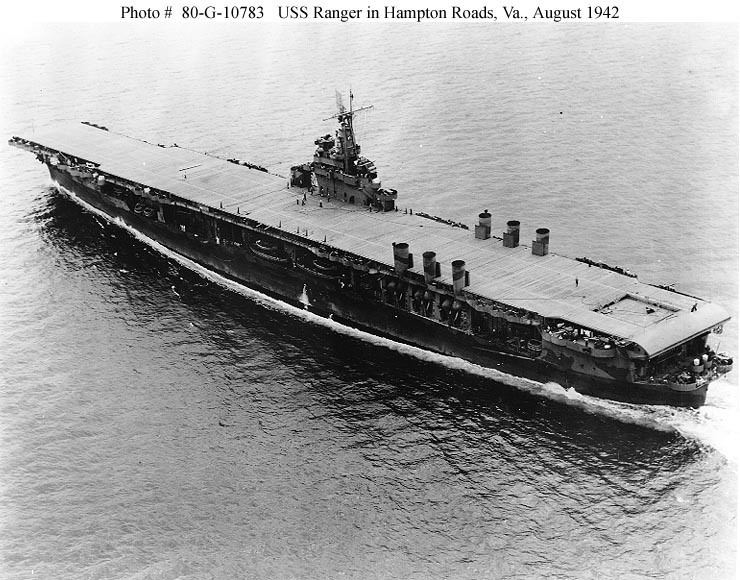 | ||
USS Ranger (CV-4) was the first ship of the United States Navy to be designed and built from the keel up as an aircraft carrier. Ranger was a relatively small ship, closer in size and displacement to the first US carrier—Langley—than later ships. An island superstructure was not included in the original design, but was added after completion. Deemed too slow for use with the Pacific Fleet's carrier task forces against Japan, the ship spent most of World War II in the Atlantic Ocean where the German fleet was a weaker opposition. Ranger saw combat in that theatre and provided air support for Operation Torch. In October 1943, she fought in Operation Leader, air attacks on German shipping off Norway. The ship was sold for scrap in 1947.
Contents
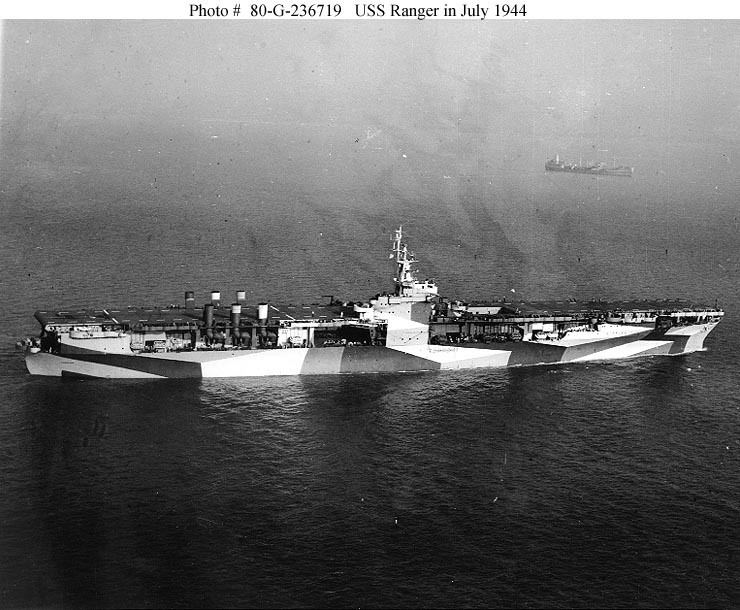
Design and development
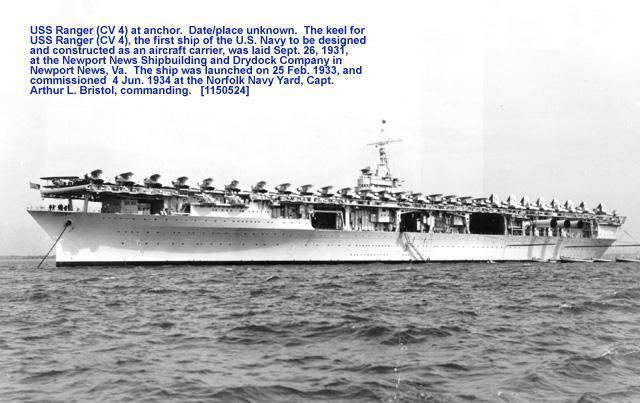
Work began in 1925 on the design of a fourth aircraft carrier for the US Navy, as a follow-on to the small Langley, converted from a collier, and the larger Lexington and Saratoga, which were in the process of being converted from incomplete battlecruisers. The Washington Naval Treaty limited both the size of individual ships that could be built and the total tonnage of aircraft carriers that could be built. After Lexington and Saratoga, there were 69,000 tons remaining for construction of aircraft carriers, and it was decided that the new ship would displace 13,800 tons, a size that would allow five carriers to be built in the remaining available tonnage. What became Ranger was to be the first purpose-built aircraft carrier of the United States Navy. The carrier cost 15.2 million dollars.
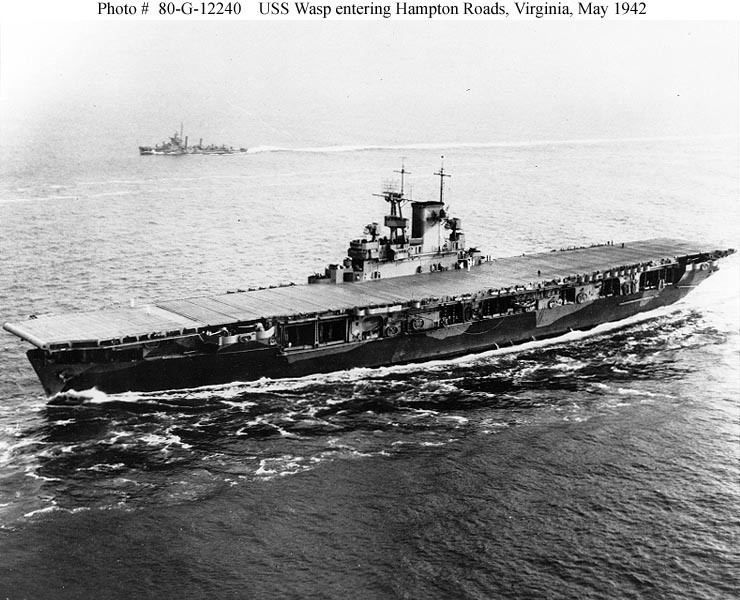
Ranger had a narrow hull due to its size and one inch of armor on the hangar deck. Due to space limits, the carrier was equipped with geared turbines. The design was modified to include an island, increasing the ship's displacement to 14,500 tons. The smoke from the ship's six boilers was vented up six small stacks, with three on each side of the aft hangar. The stacks were hinged and were rotated to a position parallel with the hangar deck during flight operations. Ranger also incorporated a gallery deck between the flight deck and hangar deck. The hangar deck was semi-open and had large roll-up metal curtain doors which could be closed in bad weather. The carrier had three elevators. One was located on the centerline and two offset to the starboard centerline. It was originally planned to install two catapults on the hangar deck to allow the launching of observation aircraft but this plan was dropped. The carrier was able to carry 76 aircraft at the time.
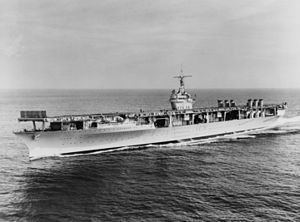
Ranger was armed with six 40 mm quadruple mounts and forty-six 20 mm mounts. She also was armed with eight 5-inch (127 mm)/25 caliber guns, which were removed in June 1944. The carrier was one of the first U.S. Navy ships mounted with light automatic weapons to defend against dive-bombing attacks, and was initially armed with forty .50 cal machine guns.
Construction
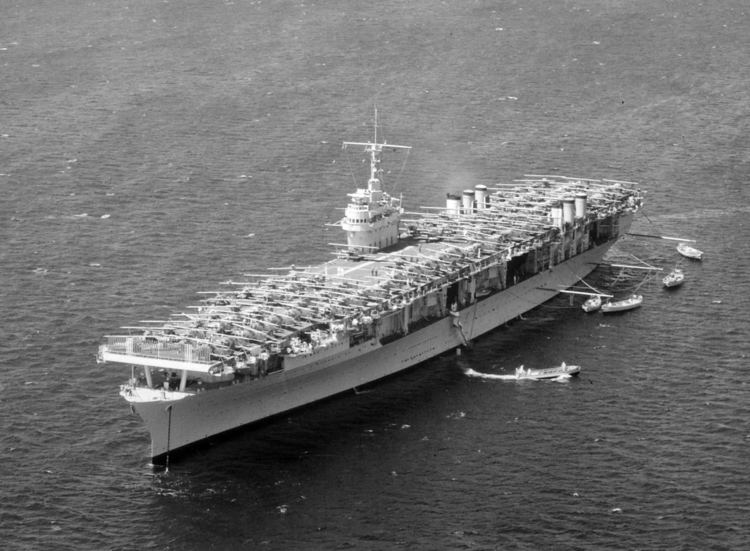
The U.S. Navy opened bids for the construction of the aircraft carrier on 3 September 1930. Newport News Shipbuilding and Drydock Company outbid Bethlehem Shipbuilding Corporation and New York Shipbuilding Company for the contract. In November, Newport News Shipbuilding received the contract to build her. On 10 December, the name Ranger was assigned to the planned aircraft carrier.
Ranger was laid down on 26 September 1931 by the Newport News Shipbuilding & Drydock Co., Newport News, Virginia, and launched on 25 February 1933, sponsored by Lou Henry Hoover (the wife of the President of the United States). The ship was commissioned at the Norfolk Navy Yard on 4 June 1934, with Captain Arthur L. Bristol in command.
Inter-war period
Ranger conducted her initial flight operations off the Virginia Capes on 21 June 1934 and departed Norfolk on 17 August for a shakedown training cruise that took her to Rio de Janeiro, Buenos Aires, and Montevideo. She returned to Norfolk on 4 October for operations off the Virginia Capes and two stints in dry dock for post trial repairs until 1 April 1935, when she sailed for the Pacific. Transiting the Panama Canal on 7 April, she arrived in San Diego on 15 April. For nearly four years, she participated in fleet problems reaching to Hawaii, the first-ever carrier cold weather test trials in Alaska, and in western seaboard operations that took her as far south as Callao, Peru, and as far north as Seattle, Washington. On 4 January 1939, she departed San Diego for winter fleet operations in the Caribbean based at Guantánamo Bay, Cuba. She then steamed north to Norfolk, arriving on 20 April.
Ranger cruised along the eastern seaboard out of Norfolk and into the Caribbean Sea. In the fall of 1939, she commenced Neutrality Patrol operations, operating out of Bermuda along the trade routes of the middle Atlantic and up the eastern seaboard up to NS Argentia, Newfoundland.
In December 1940, Ranger's VF-4 became one of the first units to receive the newer Grumman F4F-3 Wildcats.
1942
In December 1941, she was returning to Norfolk from an ocean patrol extending to Port of Spain, Trinidad and Tobago, when the Japanese attacked Pearl Harbor. Arriving in Norfolk on 8 December, she sailed on 21 December for patrol in the South Atlantic. She then entered the Norfolk Navy Yard for repairs on 21 March 1942. Ranger was one of 14 ships to receive the early RCA CXAM-1 radar.
Ranger served as flagship of Rear Admiral A. B. Cook, Commander, Carriers, Atlantic Fleet—until 6 April 1942, when he was relieved by Rear Admiral Ernest D. McWhorter, who also broke his flag in Ranger.
Steaming to Naval Air Station Quonset Point, Rhode Island, Ranger loaded 68 Curtiss P-40Es and put to sea on 22 April, launching the Army planes on 10 May to land at Accra, on the Gold Coast of Africa (Ghana). She returned to Quonset Point on 28 May, made a patrol to Argentia, then steamed out of Newport on 1 July with another 72 Army P-40s, which she launched off the coast of Africa for Accra on 19 July. Both groups of P-40Es were en route to augment the American Volunteer Group Flying Tigers (soon to be redesignated as the Army Air Forces' 23rd Fighter Group) in China, to replenish their losses as well as forming a second unit, the 51st Fighter Group. After calling at Trinidad, she returned to Norfolk for local battle practice until 1 October, then based her training at Bermuda, in the company of four new Sangamon-class escort carriers, ships converted from oil tankers to increase U.S. air power in the Atlantic Ocean.
As the largest carrier in the Atlantic Fleet, Ranger led the task force that comprised herself and the four escort carriers. These provided air superiority during the amphibious invasion of Vichy-ruled French Morocco. On 8 November 1942, Allied landings in French North Africa (Operation Torch) began. Vichy French government forces attacked the Allied forces in defense of the neutrality of French Morocco, in what became known as the Naval Battle of Casablanca.
It was still dark at 06:15 that day, when Ranger—stationed 30 mi (48 km) northwest of Casablanca—began launching her aircraft to support the landings made at three points on the Atlantic coast of North Africa (Operation Torch). Nine of her Grumman F4F Wildcat fighters attacked the Rabat and Rabat-Sale aerodromes, headquarters of the French air forces in Morocco. Without loss to themselves, they destroyed seven planes at one field, and fourteen bombers at the other. Another flight destroyed seven planes on the Port Lyautey field. Some of Ranger's planes strafed four French destroyers in Casablanca Harbor, while others strafed and bombed nearby shore batteries.
Vichy French battleship Jean Bart opened fire with the four 380 mm (15 in) guns of her one operational turret on U.S. warships covering the landings. She was hit and moderately damaged by Ranger's dive bombers, then silenced by the fifth hit from the 406 mm (16 in) guns of USS Massachusetts, which jammed the rotating mechanism of the one working turret.
Jean Bart's 380 mm turret was quickly repaired. On 10 November, Jean Bart opened fire again, and almost hit USS Augusta, the Task Force 34 flagship. In retaliation, bombers from Ranger inflicted severe damage on Jean Bart with two heavy bombs hitting the bow and the stern, causing the French battleship to sink into the harbor mud with decks awash.
In addition to damaging and sinking Jean Bart, Ranger's attack aircraft scored two direct bomb hits on the French destroyer leader Albatros, completely wrecking her forward half and causing 300 casualties. They also attacked the French cruiser Primauguet as she sortied from Casablanca Harbor and dropped depth charges within killing range of two submarines. Ranger's planes also knocked out coastal defense and anti-aircraft batteries, destroyed more than 70 enemy aircraft on the ground, and shot down 15 aircraft in aerial combat. It was estimated that 21 enemy light tanks were immobilized and some 86 military vehicles destroyed – most of them troop-carrying trucks. Ranger had launched 496 combat sorties in the three-day operation, with 16 planes lost or damaged beyond repair.
Casablanca capitulated to the American forces on 11 November. Ranger departed from the Moroccan coast on 12 November, returning to Hampton Roads on 24 November and Norfolk on 14 December 1942.
1943
Following training in Chesapeake Bay, Ranger underwent an overhaul at the Norfolk Navy Yard from 16 December 1942 – 7 February 1943. She next transported 75 P-40L fighters of the Army Air Forces' 58th Fighter Group to Africa, arriving at Casablanca on 23 February. On 25 April 1943 German radio announced "Achtung! Achtung! We are proud to announce that a German submarine has sunk the United States aircraft carrier Ranger in the North Atlantic!" Following this broadcast, German news releases reported that Commander Otto von Bülow of the U-boat U-404, personally decorated by Adolf Hitler with Oak Leaves to the Knight´s Cross, had "in addition to torpedoing four steamers, caught and sank the American aircraft carrier Ranger." The US Navy, concerned about the impact of the German announcement on families of Ranger crewmen, issued a denial of the German claim. In the radio broadcast dated 15 February 1944, Captain Gordon Rowe, Commander of USS Ranger, stated: "The story that we were sunk was a coward's trick—spreading anxiety and fear among the innocent.... The next day we issued a denial and ... on October 4 we spread panic and chaos in the Norwegian shipping lanes. Only one thing we regret. We kept looking for the Tirpitz but either she wouldn't or couldn't come out.... Meanwhile the Ranger, still very much afloat, is doing her job." She patrolled and trained pilots along the New England coast steaming as far north as Halifax, Nova Scotia. Departing from Halifax on 11 August, she joined the British Home Fleet at Scapa Flow, Scotland on 19 August, with which she patrolled the approaches to the British Isles.
Ranger departed from Scapa Flow with the Home Fleet on 2 October to attack German shipping in Norwegian waters (Operation Leader). The objective of the force was the northern Norwegian port of Bodø. The task force reached launch position off Vestfjorden before dawn on 4 October completely undetected. At 06:18, Ranger launched 20 SBD Dauntless dive bombers and an escort of eight Wildcats. One division of dive bombers attacked the 8,000-long-ton (8,100 t) freighter La Plata, while the rest continued north to attack a German ship convoy. The bombers severely damaged a 10,000-long-ton (10,000 t) tanker and a smaller troop transport. They also sank two of four small German merchant ships in the Bodø roadstead.
A second attack group from Ranger—consisting of 10 Grumman TBF Avenger torpedo bombers and six Wildcats—destroyed a German freighter and a small coastal ship, and bombed a troop-laden transport. Three of the aircraft were lost to anti-aircraft fire. On the afternoon of 4 October, Ranger was located by three German aircraft; her combat air patrol shot down two of the enemy planes and chased away the third.
Ranger returned to Scapa Flow on 6 October. She patrolled with the British 2nd Battle Squadron in waters extending northwestward to Iceland, and then she departed from Hvalfjord on 26 November, arriving at Boston on 3 December.
1944–1945
On 3 January 1944, Ranger became a training carrier out of Quonset Point, Rhode Island. This duty was interrupted on 20 April when she steamed to Staten Island, New York to take on 76 Lockheed P-38 Lightning fighters—together with Army, Navy, and French Navy personnel—for transportation to Casablanca. Steaming out on 24 April, she arrived at Casablanca on 4 May. The new aircraft were replaced with damaged U.S. Army aircraft marked for repair in the U.S., while military passengers were embarked for the return to New York City.
Prior to her returning to the U.S., Chief of Naval Operations Admiral Ernest King had planned to overhaul the carrier by lengthening the hull and installing new engines. Ranger had been designed in the late 1920s, and consequently was smaller, slower, less armored, and carried fewer aircraft and ammunition supplies than the rest of the U.S. carrier fleet. Admiral King favored having the conversions done, but his staff officers pointed out that the resources required to accomplish this would impact on the construction and repair of newer, larger, and more capable aircraft carriers. Based on this information, the full project was canceled. After arriving at New York Harbor on 16 May, Ranger entered the Norfolk Navy Yard to have her flight deck strengthened, new aircraft catapults installed, and radar equipment updated. This provided her with the capability of night fighter-interceptor training. On 11 July, she departed from Norfolk and headed for Panama. She transited the Panama Canal five days later, embarked several hundred U.S. Army passengers at Balboa, Panama, then sailed to San Diego, arriving there on 25 July. After embarking the men and aircraft of Night Fighting Squadron 102 and nearly 1,000 U.S. Marines, Ranger steamed for Hawaiian waters on 28 July, reaching Pearl Harbor on 3 August. During the next three months, Ranger conducted night carrier flight training operations out of Pearl Harbor.
Ranger departed from Pearl Harbor on 13 October to train new naval pilots for combat duty. Operating out of San Diego under the Commander, Fleet Air, Alameda, California, Ranger continued training air groups and squadrons along the California coast throughout the remainder of the war. Ranger was the only pre-war U.S. carrier to have never engaged Japanese forces in battle.
Final operations
Departing San Diego on 30 September 1945, she embarked civilian and military passengers at Balboa and then steamed for New Orleans, Louisiana, arriving on 18 October. Following Navy Day celebrations there, she sailed on 30 October for brief operations at Pensacola, Florida. After calling at Norfolk, she entered the Philadelphia Naval Shipyard on 19 November for overhaul. She remained on the eastern seaboard until decommissioned at the Norfolk Naval Shipyard on 18 October 1946. Struck from the Naval Vessel Register on 29 October, she was sold for scrap to Sun Shipbuilding and Drydock Company, Chester, Pennsylvania on 31 January 1947.
Awards
For her service Ranger was awarded two Service stars and the following ribbons/awards. The 2 Service stars awarded to Ranger were awarded based on her participation in the operations detailed below.
